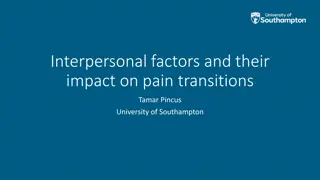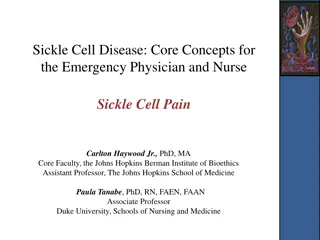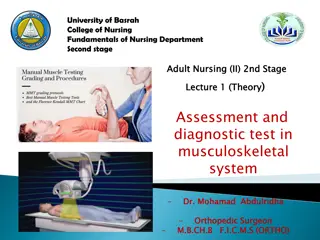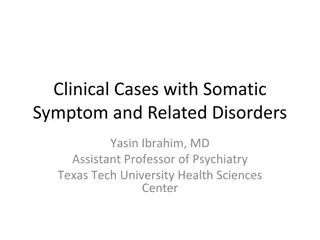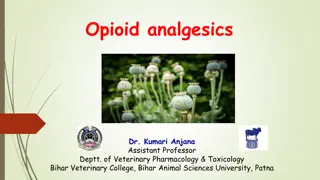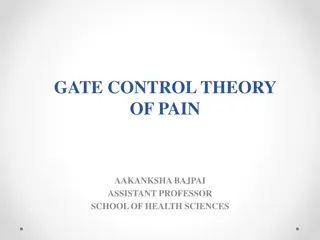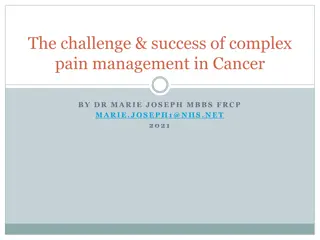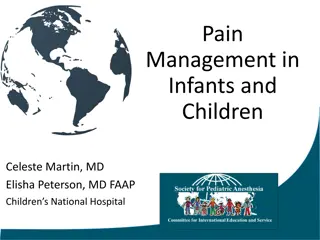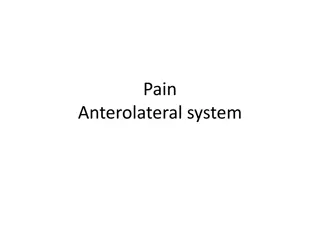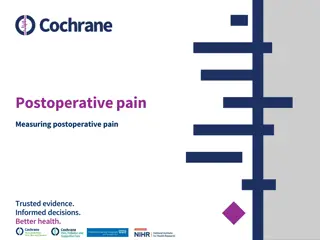Pain
Pain is a complex response to damaging stimuli, involving various receptors and nerve fibers. This study delves into the types of painful stimuli, pain receptors, nerve fibers transmitting pain signals, and the classification of pain as fast or slow. Exploring how pain is a protective mechanism, the content also covers the pain analgesia system. Images and detailed explanations provided by Dr. Massara Ghassan from the Physiology Department at the College of Medicine, University of Basrah enhance comprehension of pain mechanisms.
Download Presentation

Please find below an Image/Link to download the presentation.
The content on the website is provided AS IS for your information and personal use only. It may not be sold, licensed, or shared on other websites without obtaining consent from the author.If you encounter any issues during the download, it is possible that the publisher has removed the file from their server.
You are allowed to download the files provided on this website for personal or commercial use, subject to the condition that they are used lawfully. All files are the property of their respective owners.
The content on the website is provided AS IS for your information and personal use only. It may not be sold, licensed, or shared on other websites without obtaining consent from the author.
E N D
Presentation Transcript
Pain Dr. massara ghassan Physiology Department College of Medicine\ University of Basrah
Objectives 1. What is pain? 2. Types of painful stimuli. 3. Pain receptors 4. Nerve fibers that transmit pain signals. 5. Classification of pain 6. Pain analgesia system University of Basrah-College of Medicine-Physiology Department 1
Pain is a protective mechanism which occurs when tissues being damaged. In response to: 1. Painful stimuli 2. Even by simple activation , like sitting , in sitting in the same position for a long time. 2 University of Basrah-College of Medicine-Physiology Department
compression on the tissues lack of blood flow Sitting for a long time person change his position tissue destruction Ischemia 3 University of Basrah-College of Medicine-Physiology Department
Painful stimuli 3 Types of Stimuli . Mechanical . Thermal . Chemical 4 University of Basrah-College of Medicine-Physiology Department
How theses Stimuli Produce pain?? pain receptors Are all free nerve endings They are widespread in the superficial layers of the skin as well as in certain internal tissues 5 University of Basrah-College of Medicine-Physiology Department
Three Types of pain receptors 1. Mechanical nociceptors Strong pressure (e.g from a sharp object) 2. Thermal nociceptors Skin temperatures above 45c Severe cold 3. Chemically sensitive nociceptors Various agents like bradykinin , histamine, high acidity and environmental irritant. 6 University of Basrah-College of Medicine-Physiology Department
Classification of pain Fast pain : Bright, sharp localized pain. Plays an important rule in making the person react immediately to remove himself or herself from the stimulus. Slow pain : Painful stimuli followed by a dull intense, diffuse, and unpleasant feeling ( slow (chronic) pain) Tends to become greater overtime and makes the person keep trying to relieve the cause of the pain . 7 University of Basrah-College of Medicine-Physiology Department
Fast pain Mechanical, thermal nociceptors Type A fibers Neurotransmitter: Glutamate. Slow pain Mechanical, thermal, chemical Type C fibers Neurotransmitter is : substance p 8 University of Basrah-College of Medicine-Physiology Department
9 University of Basrah-College of Medicine-Physiology Department
Pain also classified in to Superficial pain Visceral pain Deep pain 10 University of Basrah-College of Medicine-Physiology Department
Deep pain Come from deep tissues like fascia, muscles and bones There is little rapid , bright pain , because of relative deficiency of A delta nerve fibers in deep structures. Deep and visceral pain are poorly localized , nauseating, and frequently associated with sweating and changes in blood pressure 11 University of Basrah-College of Medicine-Physiology Department
Visceral pain Come from the viscera of the body Poorly localized unpleasant and associated with nausea and autonomic symptoms Visceral pain often radiates or is referred to other areas. Highly localized types of damage to the viscera seldom cause severe pain.(surgeon can cut the gut entirely) Conversely, any stimulus that causes diffuse stimulation of pain nerve endings throughout a viscous causes severe pain e.g ischemia. 12 University of Basrah-College of Medicine-Physiology Department
Nociceptors a. Can be activated by strong pressure, severe cold, severe heat and chemicals b. Are specialized structures located in the skin and joints only. c. Are innervated by Type B nerve fibers d. All of the above 13 University of Basrah-College of Medicine-Physiology Department
Referred pain A person feels pain in a part of the body that is fairly remote from the tissue. Best known examples: 1. Referred of cardiac pain to the inner aspect of the left arm 2. Pain in the tip of shoulder caused by irritation of the central portion of the diaphragm 14 University of Basrah-College of Medicine-Physiology Department
Mechanism of referred pain The Dermatomal rule: Pin is referred to structures that developed from the same embryonic segment or dermatome. Convergence_ projection theory: Convergence of somatic and visceral pain fibers on the same second order neurons. 15 University of Basrah-College of Medicine-Physiology Department
16 University of Basrah-College of Medicine-Physiology Department
17 University of Basrah-College of Medicine-Physiology Department
Analgesia System 1. Periaqueductal gray and periventricular areas 2. Raphe Magnus nucleus and nucleus reticularis paragigantocellularis 3. Pain inhibitory complex 18 University of Basrah-College of Medicine-Physiology Department
Enkephalin cause inhibition of incoming type C and type A pain fibers 19 University of Basrah-College of Medicine-Physiology Department
Inhibition of Pain Transmission by Simultaneous Tactile stimulation mechanoreceptive tactile receptor Lateral inhibition pain 20 University of Basrah-College of Medicine-Physiology Department
Some Clinical Abnormalities Hyperalgesia an exaggerated response to a noxious stimulus Allodynia a sensation of pain in response to a stimulus, that dose not normally elicit pain. 21 University of Basrah-College of Medicine-Physiology Department


